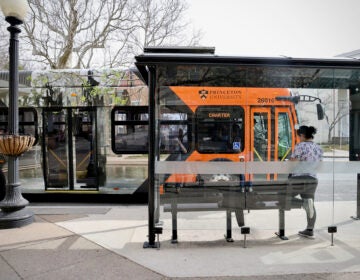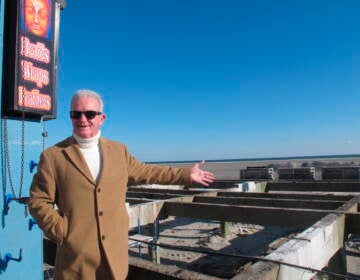What’s the verdict on New Jersey’s decision to privatize toxic cleanups?
Listen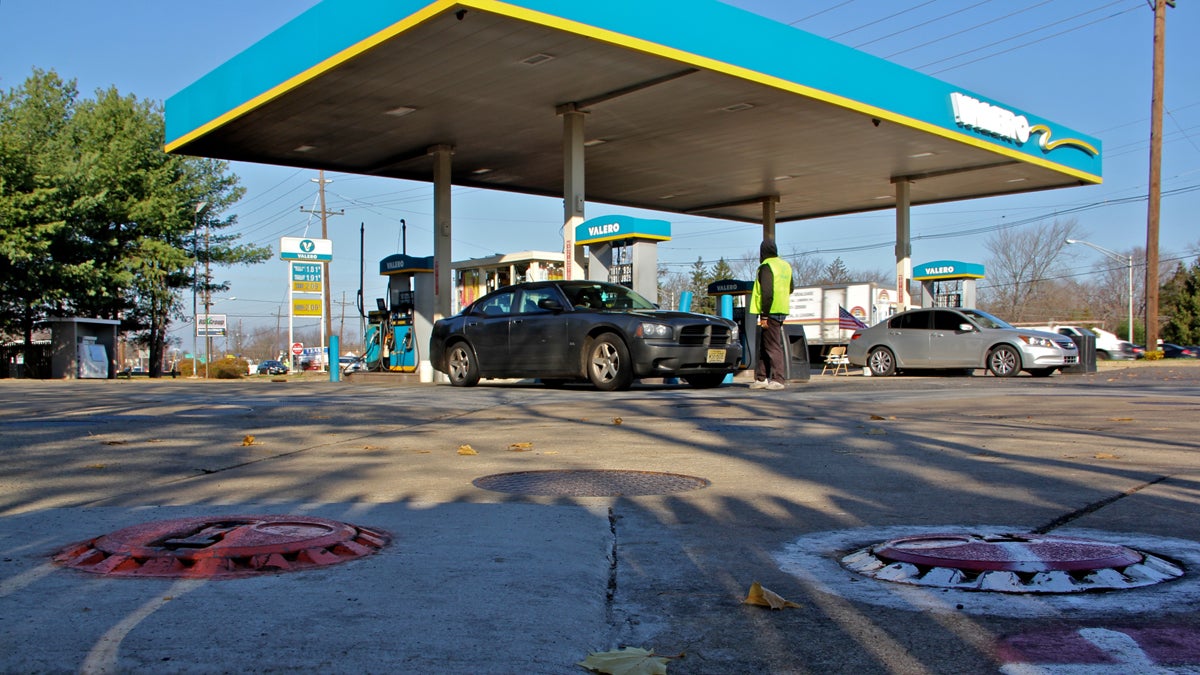
The ground under a Maple Shade gas station was contaminated by a fuel spill from underground storage tanks. (Emma Lee/WHYY)
If you live or work in New Jersey, you probably see toxic sites all the time without even knowing it.
The state has a reputation for foul-smelling smokestacks that rise above the Turnpike. But New Jersey also contains thousands of smaller contaminated sites hidden in plain view — gas stations, dry cleaners, factories, schools, and even homes.
Cleaning up all of these sites became such a burden on the state that, in 2009, Gov. Jon Corzine signed the Site Remediation Reform Act to deal with remediation more quickly.
The SRRA achieved that goal by handing over authority of many toxic site cleanups to the private sector, a job that had previously been done by the state Department of Environmental Protection.
A chorus of opponents rose in opposition to the law, saying environmental professionals paid to clean up toxins in a flash was akin to “the fox guarding the henhouse,” but their pleas went unanswered.
Now that the SRRA has been law for six years, it’s worth examining how the contentious idea has played out across the Garden State.
Something rotten in the state of New JerseyIn the early 2000s, the state Department of Environmental Protection had a problem.
About 20,000 problems, actually.
That’s how many sites were languishing in the DEP’s site remediation program, awaiting cleanup from an overburdened and understaffed state agency still feeling the aftereffects of staff and funding cuts in the late 1990s.
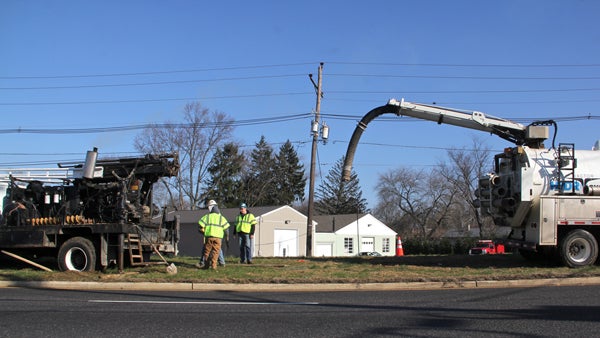 Workers prepare to drill a test well in the Route 73 median, down stream from the gas station. This will show how far groundwater has carried the contamination. (Emma Lee/WHYY)
Workers prepare to drill a test well in the Route 73 median, down stream from the gas station. This will show how far groundwater has carried the contamination. (Emma Lee/WHYY)
“It just became very, very difficult for the existing staff to manage the amount of cases that were coming through the department,” said Mark Mauriello, who was serving as DEP Commissioner in 2009.
Mauriello said the small staff could only slowly chip away at the 20,000 contaminated sites, “which is not good environmentally, and it’s not good for communities, and it’s not good for the property owners who are trying to get these sites back into productive use.”
The Legislature passed the Site Remediation Reform Act, which took several steps to speed up toxic cleanups in New Jersey, so that sites would be cleared faster and so DEP personnel could focus on cases that posed an imminent danger to the public.
The broadest and most contentious provision of the SRRA created a class of private workers called Licensed Site Remediation Professionals, or LSRPs, to replace DEP case managers in most (but not all) toxic cleanups.
Previously a DEP case manager was responsible for developing, overseeing, and signing off on a toxic site cleanup. A property owner might hire an environmental consultant (many of whom became LSRPs after 2009) to work with the DEP representative, but the agency decided how the work would be done.
Now LSRPs would be responsible for developing, overseeing, and signing off on remediations. A property owner would work directly with the LSRP, not the DEP. Although the DEP would review paperwork an LSRP submits including the final report, it would take a backseat for the day-to-day operations of site remediation, playing a much less active role than it had in years past.
Toxic site cleanup in New Jersey had been privatized.
On siteOn one stretch of Rt. 73 in South Jersey, it feels like there is a gas station on every corner. At least one of them is contaminated.
LSRP Phillip Brilliant is overseeing the remediation of a service station in Maple Shade, Burlington County where an old underground tank leaked gasoline into the nearby soil and groundwater.
“You’ll see some little concrete patches on the asphalt, and these are monitoring wells,” he told me when I caught up with him in early December.
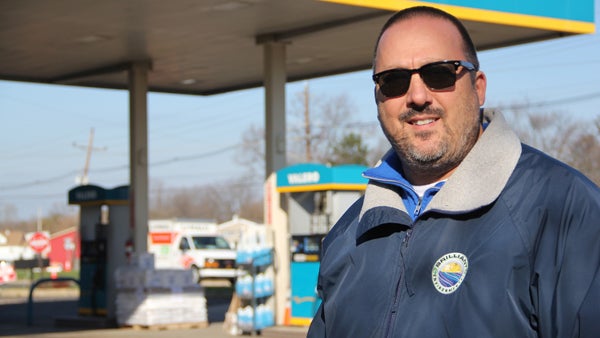 Philip I. Brilliant of Brilliant Environmental Services is overseeing the clean up of a spill at a gas station in Maple Shade. (Emma Lee/WHYY)Brilliant and a handful of workers were drilling into the median to install a monitoring well, in hopes of assessing how far the contamination had spread.
Philip I. Brilliant of Brilliant Environmental Services is overseeing the clean up of a spill at a gas station in Maple Shade. (Emma Lee/WHYY)Brilliant and a handful of workers were drilling into the median to install a monitoring well, in hopes of assessing how far the contamination had spread.
“We’ve put monitoring wells in the ground, we look for the first groundwater … and we look for gasoline, which is a floater,” he said.
As the LSRP for this gas station, Brilliant bears responsibility for the entire cleanup, from conducting a historical investigation and chemical sampling to devising a remediation plan.
He was hired and paid by the property owner (or “responsible party,” in the parlance of site remediation) but assures me that his first priority is the “protection of public health and safety and the environment,” which is codified in the SRRA.
“Constantly thinking about that,” Brilliant said, adding that it is also in the best interest of property owners not to skimp on cleanup.
“When things are cleaned up, it’s a value to [the property owner]. When the next door neighbor is complaining because there’s a contaminated site next door and it’s in the front page of the paper, there’s no value to [the property owner],” he said.
Brilliant said when he used to work on behalf of property owners in what amounted to site remediation negotiations with the DEP, his back-and-forth with the department would bog down the pace of the cleanup. Now, as an LSRP free to make his own decisions about cleanup, Brilliant can remediate sites much faster.
“You’re not waiting for somebody at DEP to pick a report up from a file cabinet and take a look at it and come back to you with responses,” he said.
That has made the LSRP program an outright success in the eyes of its supporters.
According to the DEP there were around 20,000 sites in New Jersey’s toxic site remediation program (which also includes some sites LSRPs would not work on) in 2009.
Today there are just over 14,000.
Last year the DEP closed more toxic cleanup cases than it opened new ones, a first for the department.
But while LSRPs and developers applaud the autonomy and speed they now have to call the shots on a given site, the idea worries many in the environmental community, including Dr. Michael Gochfeld, professor emeritus at Rutgers Environmental and Occupational Health Sciences Institute.
“I think that the notion that somehow privatization is a magical cure is wrong,” he said.
Gochfeld and others argue that turning over authority to private professionals with limited DEP oversight means that much information about toxic sites across New Jersey will remain unknown.
He said it opens up the program to the possibility of abuse by LSRPs and property owners, because the DEP cannot micromanage every private contractor working on toxic site remediation.
“I don’t know that the system isn’t working,” Gochfeld said. “It’s just a fundamental suspicion I have that it’s conducive to not working.”
The buck stops where?The Site Remediation Reform Act gave LSRPs their power, but it also put considerable checks on that power.
Each applicant to the LSRP program is vetted by a licensing board, which is made up of 13 members including state government officials, site remediation professionals, environmentalists, businesspeople, and academics. (Phillip Brilliant is a member of the board.)
The law also established what sort of professional background a potential LSRP would need, mandating that an applicant have eight years full-time site remediation experience, health and safety training, and no convictions of an environmental crime, among other requirements.
More importantly, it tasked the licensing board with monitoring every LSRP working in New Jersey. The board randomly audits 10 percent of LSRPs each year and fields complaints about LSRPs, which it investigates to determine whether it will penalize the worker. (This is separate from the DEP inspections of paperwork submitted by LSRPs.)
Until recently the board had only penalized LSRPs with written reprimands or small fines.
But in November it voted to temporarily suspend the license of one LSRP, the first time the board took that step.
“There’s a level of accountability of the environmental professionals out there,” said Mark Pedersen, assistant commissioner of the DEP’s Site Remediation and Waste Management Program. “They take the responsibility of their job very seriously and the loss of their license. That’s important to understand.”
Proponents argue that the penalties for doing a shoddy cleanup and the knowledge that that LSRPs bear the ultimate responsibility for a site means they will not try to game the system
Pedersen described a recent meeting he had with a group of LSRPs, in which he asked one woman about her experience in the program so far.
“I said, ‘so tell me how it’s working for you.’ And she looked at me panicked. First thing out of her mouth was, ‘I can’t sleep at night.’”
Pedersen says the anecdote shows how seriously LSRPs take their job.
In fact, according to Pedersen, only 2-3 percent of the nearly 7,000 cases closed by LSRPs were withdrawn by the contractors. The DEP invalidated only nine projects so far, a batting average the agency applauds.
Critics counter that there may be much more error and malfeasance throughout the program, but the relaxed DEP oversight means no one knows about it.
“We don’t necessarily know what is still in the ground and we really have to trust the professional judgment of these privatized individuals,” said Doug O’Malley, director of Environment New Jersey.
What’s more, O’Malley alleged that the SRRA also weakened cleanup standards, thanks to the collaborative efforts of the DEP and the LSRP community.
“You essentially have an insider club,” O’Malley said. “They have successfully worked to weaken standards and to make it easier so they wouldn’t get in trouble.”
Mauriello, who served as DEP commissioner in 2009, has seen the law play out from both sides of the line.
After retiring in 2010, Mauriello began working as the director of environmental affairs and planning for the real estate development company Edgewood Properties, where he regularly works with LSRPs.
“I’ve been pleasantly surprised at the degree of professionalism and care the care that these LSRPs take in doing their work,” he said.
“I participate in discussions where the clients are asking questions like, ‘Do we really have to do that much work?” Mauriello said. “And the answer that we always get from our LSRP and [which] I often hear from the LSRPs that we work with … is, ‘I’m concerned that we get this right and I need to be sure that when I submit my reports and my data to the DEP that it will be right. I have a lot at stake here.’”
This story is part of Dirty Little Secrets, a series investigating New Jersey’s toxic legacy. Participating news partners include New Jersey Public Radio/WNYC, WHYY, NJTV, NJ Spotlight, Jersey Shore Hurricane News, WBGO, New Brunswick Today and the Rutgers Department of Journalism and Media Studies. The collaboration is facilitated by The Center for Investigative Reporting, with help from the Center for Cooperative Media at Montclair State.
WHYY is your source for fact-based, in-depth journalism and information. As a nonprofit organization, we rely on financial support from readers like you. Please give today.


